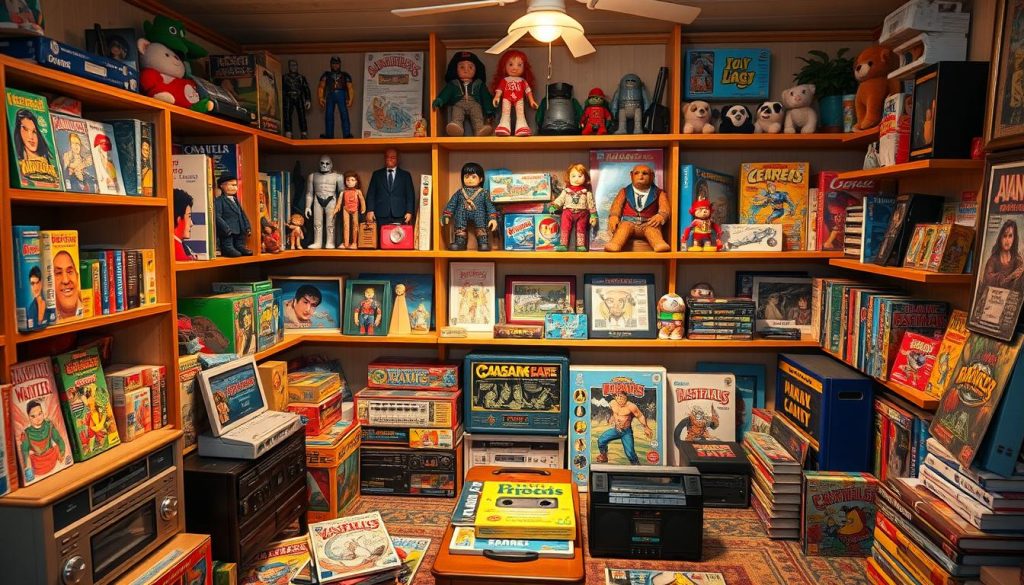Starting a toy collection is exciting and can be a good investment. If you’re new to this, learning the basics is key. This guide will teach you how to pick themes, where to find toys, how to budget, and how to show off your collection.
The American Society of Appraisers says knowing your collection’s value is important. The Toy Association keeps you updated on what’s trending. And Forbes lets you know the pros and cons of toy investing.
Key Takeaways
- Starting a toy collection is both a fun hobby and a potential investment.
- Essential steps include choosing a theme, sourcing items, setting a budget, and display strategies.
- The American Society of Appraisers offers guidance on valuing collectibles.
- The Toy Association provides insight into toy market trends.
- Forbes discusses the investment benefits and risks of toy collecting.
Understanding the Appeal of Toy Collecting
The hobby of collecting toys is rich and complex, appealing to many for various reasons. Some people enjoy reliving their childhood, while others love the excitement of finding unique toys. This makes the world of toy collecting very special.
The Nostalgia Factor
Nostalgia is a big draw for toy collectors. They collect toys from their past to feel connected to happy, simpler times. Psychology Today says that old toys can be reminders of our childhood, bringing us comfort and joy. This emotional connection makes collecting toys a very personal and rewarding hobby.
The Thrill of the Hunt
Finding rare toys is thrilling for collectors. It’s exciting to hunt for these items, whether at shows or online. AARP talks about how finding a rare piece can give a collector great joy and a sense of accomplishment. This search is a big part of what makes toy collecting fun.
Different Types of Collectors
Toy collectors come from all walks of life, from casual hobbyists to serious investors. Casual collectors might look for toys that remind them of their childhood. Serious collectors might search for valuable pieces as investments. Antiques Collecting Magazine states that understanding these differences can help collectors focus their collecting goals. This makes building a toy collection more meaningful.
Setting a Budget for Your Collection
Starting a toy collection means you need a budget. This helps you enjoy collecting without worrying about money. Planning your finances means you can collect toys for a long time, without trouble.
Determining Initial Investment
The first step is figuring out the starting cost. This covers buying your first items, like rare figures or vintage dolls. Look into their prices and decide on your spending limit. Make sure it fits your budget.

Ongoing Costs and Maintenance
Keeping a collection costs extra. Think about storage, upkeep items, and fixing things. For example, shelves and cases keep toys safe from dust and harm. Budget for regular cleaning to keep everything looking great.
Tips for Staying Within Budget
Sticking to your budget can be hard, but here are some ideas:
- Set a monthly or yearly spending limit and stick to it.
- Track all purchases to monitor spending patterns and identify areas to cut back if necessary.
- Prioritize high-value or rare items over lower-cost, easily accessible toys.
- Consider trading or selling less favored items to finance new acquisitions.
- Seek out deals, attend sales, and join collector communities for potential discounts and swaps.
Choosing Your Focus: What to Collect
Picking what to collect in toys matters a lot. It makes your collection special and well-arranged. Focusing on certain toys like action figures or vintage toys can make collecting more fun. It’s all about finding what you love, whether that’s LEGO, Funko Pop, or something else.
Popular Toy Categories
You can have more fun and add value by focusing on certain types of toys. There are lots of categories to choose from. For instance, action figures, die-cast cars, and dolls are all popular. Exploring these can help you find the perfect niche that feels right for you.
Researching Trends and Values
Knowing the value of toys and what’s trending can guide your collecting. Sites like The Toy Insider show what toys are hot now. Auctions like Heritage Auctions give insights on what collectibles are worth. This info helps grow your collection in both fun and value.
| Resource | Focus | Benefits |
|---|---|---|
| The Toy Insider | Popular Toy Categories | Insights on trends |
| Heritage Auctions | Toy Values | Current collectible values |
| Toy News International | Collector Stories | Personal success stories |
Finding Your Personal Connection
Your toy collection should show what you love. Many people collect toys they loved as kids or brands that bring back memories. Discovering what clicks with you makes the journey worthwhile. This makes your collection not just toys, but a piece of your story.
Sourcing Your Toys: Where to Look
Looking for the perfect addition to your toy collection means checking out different places. You might want vintage treasures or the latest cool toys. Knowing the best spots to find collectible toys can really boost your collection.
Local Stores and Flea Markets
Start your toy hunt at local stores and flea markets. You can find unique toys and hidden treasures there. Weekends at markets and local toy shops are great for finding both old and new items.
Online Marketplaces
Online marketplaces like eBay and Amazon offer ease and a huge variety. They have everything from rare vintage toys to the newest must-haves. It’s easy to compare prices and check reviews online, helping you buy smarter.
Auctions and Collector Shows
Toy shows and auctions are where you can find rare and valuable toys. They let you meet other toy lovers and find items you won’t see anywhere else. Going to these shows means you can see toys up close and connect with fellow collectors.
| Source | Advantages | Considerations |
|---|---|---|
| Local Stores & Flea Markets | Unique finds, support local businesses | Limited selection, variable pricing |
| Online Marketplaces | Convenience, extensive variety | Shipping costs, potential for scams |
| Auctions & Collector Shows | Rare finds, networking opportunities | Travel costs, competitive bidding |
Organizing and Displaying Your Collection
Organizing and showing off your toy collection can make it look great and keep its value. Using the right storage and display ideas turns your collection into an amazing display. It also protects your toys. Keeping good records is key for insurance purposes.
Best Practices for Storage
Storing your collectibles right is important to avoid damage. A climate-controlled place is best to keep temperature and humidity from harming your toys. Use acid-free boxes to keep them safe. You can also use UV protection like special glass to keep sunlight from fading your toys.
Creative Display Ideas
Showing off your toys creatively makes each one special. Use floating shelves, custom cabinets, or shadow boxes for a cool look. Group toys by theme or era for a neat display. Use LED lights in cases to showcase rare items safely.
Documenting Your Collection for Insurance
It’s important to have insurance for your toy collection. Keep detailed records, like photos, receipts, and notes about each toy’s condition and history. This helps with valuations and insurance claims if something bad happens. Make sure to keep your records up to date for full insurance protection.

